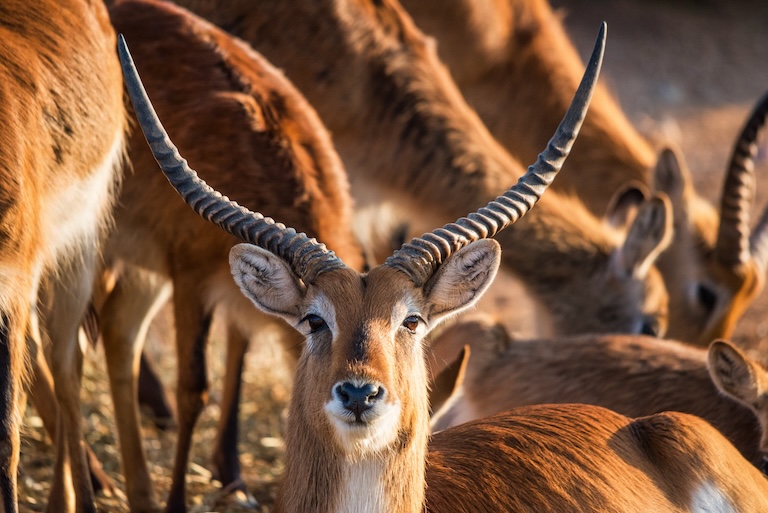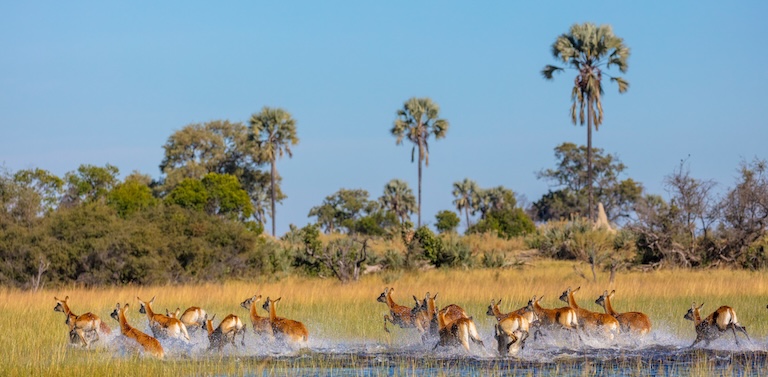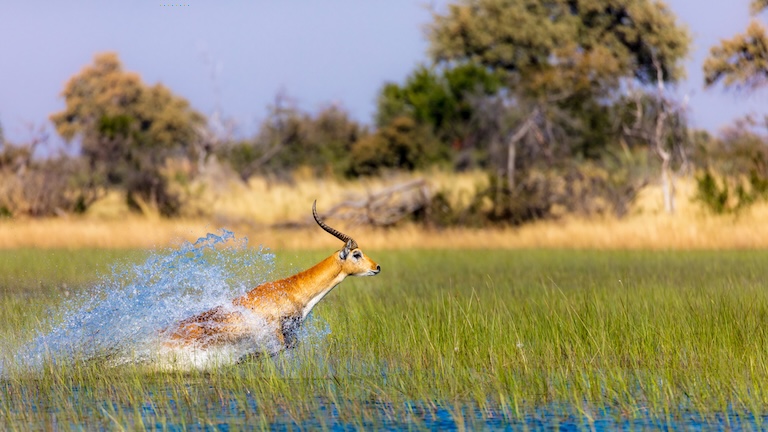Lechwe Profile
The wetlands of Africa are a small and seemingly unimportant part of the landscape, yet there’s a lot more going on there than meets the eye.
The unique species that occupy these habitats have become specialised in ways that are not found anywhere else, and as specialised organisms, they are entirely reliant on the wetlands for survival.
Sadly, to human eyes, wetlands would look much better drained and full of livestock, and this means that for animals like the Lechwe, a medium-sized wetland specialist, there’s nowhere left to turn.

Lechwe Facts Overview
| Habitat: | Wetlands |
| Location: | South-Central Africa |
| Lifespan: | 15 years in the wild, 27 in captivity |
| Size: | Up to a meter (39 in) at the shoulder |
| Weight: | Up to around 120kg (260 lb) |
| Colour: | Golden brown, white belly |
| Diet: | Aquatic plants, high-nutrient grasses |
| Predators: | Lion, leopard, cheetah, hyena, Cape hunting dog, crocodile, python |
| Top Speed: | Unknown |
| No. of Species: | 1 |
| Conservation Status: | Near Threatened globally, some subspecies Critically Endangered (IUCN) |
The lechwe may look a lot like any other wetland antelope, but it’s a very specialised semi-aquatic mammal. It’s as happy swimming as it is grazing in shoulder-deep wetness that would clog up the fur of any of your standard, dry land antelopes.
It’s a fairly unusual animal, forming large, dynamic communities and prone to the seasonal epic sex orgy or two when the time is right.
Sadly, their numbers are dwindling due to a lack of respect for their habitat and a poorly-regulated hunting problem.
Interesting Lechwe Facts
1. On the Kob
African wetlands make up only around 1% of the landmass, and are therefore home to animals found nowhere else. There are a handful of classic water-grazing species among the antelope community in Africa, all within the Reduncinae subfamily and most of which exist in the Kobus genus.
This genus is home, naturally, to the Kob, but also the waterbuck, the puku, and this guy, the Lechwe. Of all the antelope, lechwe are perhaps the most comfortable in the water.
Sometimes known as Lechwe waterbucks, this adds to the confusion when it comes to identification, but lechwe are generally less shaggy than waterbucks. Unfortunately, they’re shaggier than kob, and so the problem just sort of gets kicked down the line.
2. They have an unusual predator avoidance strategy
Lechwe are highly specialised for the water, having evolved to adapt to a degree that you don’t see in most other antelope. They’re commonly seen up to their necks in marsh and swamp, and this situates them decidedly apart from the most comfortable hunting grounds of the major predators in the area.
Water has become their refuge in a land full of running carnivores and they spend the majority of their feeding time in it. When on terra firma, they prefer termite mounds for an elevated viewpoint, and lie down in short grasses on the edge of the water.
As you’d expect, they’re excellent swimmers, and their wading lifestyle has granted them a peculiar waterproofing quality. Their legs are covered in hydrophobic oils that probably help keep them warm but also make it a lot easier to run through knee-high waters. 1

3. They can form huge orgy herds
The lechwe are highly sex-segregated for non-breeding seasons, and males are quite territorial. Males will venture farther from water than females, taking advantage of their ability to retain water to graze in other pastures.
Females and calves stay near water for safety and hydration, and form dynamic herds that change over time. Individuals and groups will come and go from these hers, and there’s no apparent hierarchy.
When it’s time to mate, huge arenas of copulation, called Leks, are formed around floodplains. Males dominate these arenas, getting their end away until they’re physically exhausted, at which point, females will find more energetic replacements.
There aren’t many animals who use this mating strategy, probably because it’s so unpleasant to clean up afterwards. 2
4. Males and females have different approaches
When lekking, females are selective with their mates. They’ll mate with more than one male, but they’re much more discerning. This is the female’s role in sexual selection for the species, and it helps to create high-fitness pairings.
The males’ job is to battle it out with other males to become the most experienced option for the picky females. This means younger bucks don’t get much of a look in until the oldest males have had their fill.
As a result, the species has evolved against early reproduction, and they experience a sort of behavioural-based delay in maturity, i.e., when it comes to mating, the size or physicality of males isn’t as relevant as their age, and youngsters will almost always be submissive to more experienced adults.
This concept has been described in other species as a sort of “psychological castration”, and is a fascinating example of the evolutionary development of social behaviours. 3
5. They can hybridise with waterbuck
If you thought discerning one water-grazing antelope from another was hard already, wait until you come across their hybrids.
Antelope have little trouble mating outside of their species in captivity, and on at least one occasion, there’s evidence of this unholy matrimony occurring in the wild, too.
This is the kind of forbidden love you’d expect in captive animals, but it’s surprising to see it happen naturally, and understanding how and why could be a very significant avenue of research. 4

6. Dams may cause problems
Despite being such a small portion of the landmass, wetlands are so often disrespected as wasted space and drained for grazing livestock.
As part of riverine systems, they’re also affected by damming, something which is of huge importance to the development of African countries in terms of both freshwater supply and electrification.
When these ecosystems are interrupted, they can be irreversibly changed, as competitive organisms take hold and sometimes invade once-balanced ecosystems.
Some wetland plants can suffer from too much water, and in the case of damming, this can wipe out nutritional essentials to the Lechwe’s diet.
Mimosa overgrowth is one example of a plant species that has displaced a lot of the local flora in the Lechwe habitats, and this could reduce viable foraging grounds, perhaps concentrating Lechwe into smaller areas, confining them alongside other animals like the waterbuck and making such adventurous sexual deviations more likely. 5
7. They’re important to the ecosystem
It’s important to remember that every ecosystem is supported by a multitude of organisms in all kingdoms: plants, animals, fungi, bacteria, and so on. The interplay between these organisms is essential to the stability of each of them, so anything that affects one animal species will necessarily have a cascade of effects on everything else.
Large herbivores like the Lechwe assert a “top down” force on the ecosystem, creating and removing niches for other organisms to spread.
Trampling, as well as nibbling, affects the type of plants that can survive in Lechwe habitats, and this also impacts the type of invertebrates that can feed on the plants in the area.
Wetlands are rare and important habitats, and their balance is far less understood than many of the more terrestrial ecosystems. Protecting them is likely to be an important key to the conservation of far more than is immediately apparent. 6

8. Multiple populations are in trouble
While there’s only one species of Lechwe, there are several subpopulations. The species as a whole isn’t in too much trouble yet, but it’s almost there. Lechwe are listed as “near threatened” by the IUCN, but this doesn’t paint the whole picture.
Isolated subspecies are not faring all that well. Southern Lechwe are already fragmented and have been eliminated by poachers from much of their range.
Damming and draining for livestock grazing have dramatically affected the Kafue Lechwe and the subspecies is listed as endangered. Upemba Lechwe numbers are even lower, likely below 1000, and this subspecies is now critically endangered due to poaching. 7
9. Wetlands are so important
These subpopulations are extremely important to the survival of the species and their protection means better management of wetlands all over their range.
Again, it’s so critical to remember that what looks like a barren boggy marsh is actually home to a wealth of species in all kingdoms that don’t exist anywhere else. Animals and plants that feed on these species evolve to become entirely reliant on them, and so a better appreciation for what’s there is key to getting public backing for its protection.
While poaching is a significant threat too, sustainable hunting can actually generate income to further protect the species, and this is another case where proper management can lead to outcomes that benefit everyone.
Meanwhile, captive populations of Southern Lechwe are found in Europe and North America and can provide genetic stock, valuable research outcomes and other crucial components to their conservation in the wild.
Lechwe Fact-File Summary
Scientific Classification
| Kingdom: | Animalia |
| Phylum: | Chordata |
| Class: | Mammalia |
| Order: | Artiodactyla |
| Family: | Bovidae |
| Genus: | Kobus |
| Species: | Leche |
Fact Sources & References
- MANI (2019), “Kafue Lechwe”, Similar But Different Animals.
- Richard H. Schuster (1976), “Lekking Behavior in Kafue Lechwe”, JSTOR.
- D. T. WILLIAMSON (1992), “Condition, growth and reproduction in male red lechwe”, Sci Hub.
- “Antelope hybrid in the wilds of northern Botswana”, africa geographic.
- M. Mumba (2005), “Hydrological and ecological impacts of dams on the Kafue Flats floodplain system, southern Zambia”, Sci Hub.
- M. Celeste Franceschini (2020), “Impacts on freshwater macrophytes produced by small invertebrate herbivores: Afrotropical and Neotropical wetlands compared”, Sci Hub.
- “Southern Lechwe”, IUCN Red List.
